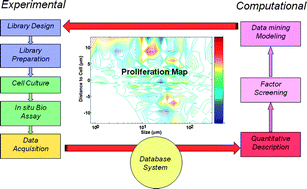The past ten years have witnessed the emergence of a new set of tools, combinatorial and high-throughput screening, in polymeric biomaterials development. These tools, developed initially in the drug-discovery industry, and later applied to catalysts and inorganic materials, allow orders of magnitude increases in the rate of exploration and characterization of new materials. This feature article covers recent examples of high-throughput and combinatorial studies of biofunctional polymers. Biofunctional polymers exhibit chemistry or physical properties specifically designed to function in a biological context. Examples include polymers with unique binding affinities or surface physical properties for gene and drug delivery, tissue engineering scaffolds, anti-fouling and anti-bacterial coatings, and biocatalytic applications.
You have access to this article
 Please wait while we load your content...
Something went wrong. Try again?
Please wait while we load your content...
Something went wrong. Try again?


 Please wait while we load your content...
Please wait while we load your content...